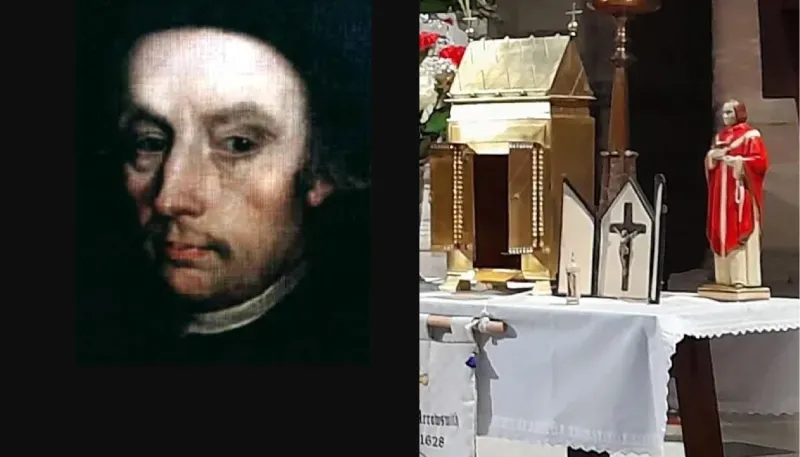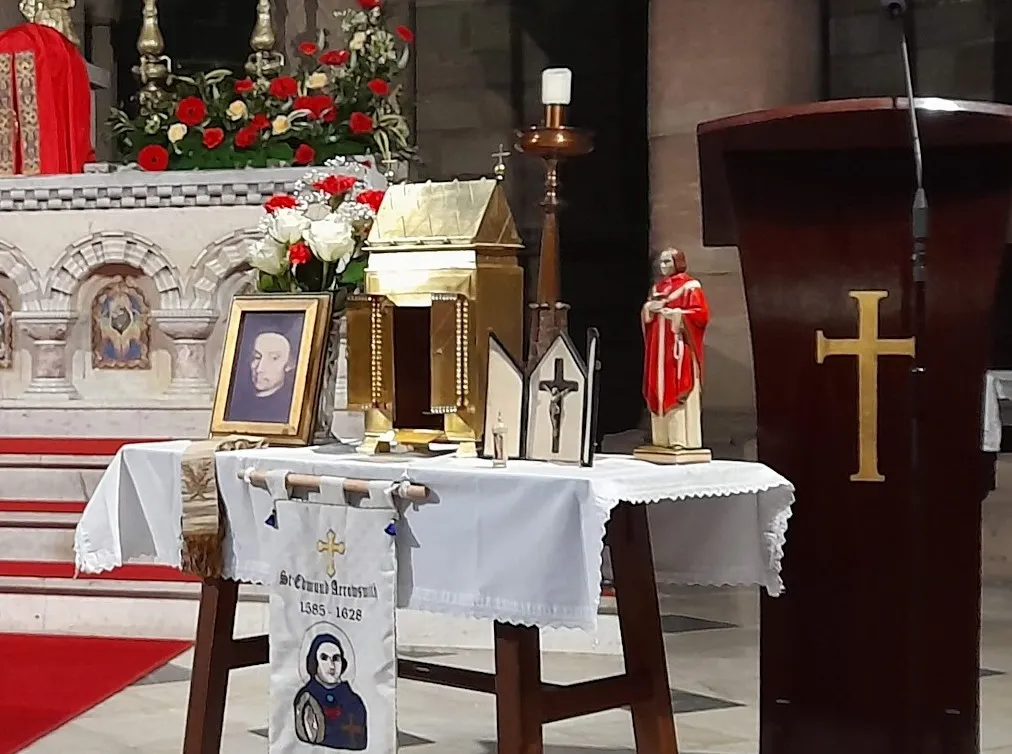
Manchester, England, Oct 1, 2022 / 06:00 am (CNA).
As Mass finished on a recent late-summer Sunday morning in northern England, people sang heartily “Faith of Our Fathers,” the anthem to the men and women who were executed by Henry VIII and Elizabeth I.
No sooner did the chords die down than the people started forming a solemn queue. As they passed by a small cylinder enclosing a withered hand — COVID’s aftermath means they still cannot touch or kiss the reliquary — each worshipper prayed a silent prayer.
The hand belongs to Edmund Arrowsmith, a priest who was executed for celebrating Mass in the 17th century.

Like other martyrs of that era, he was hanged until nearly unconscious and then cut down only to be dragged through the streets lying on a hurdle before arriving at his final execution spot, where he was cut open and mutilated. (Picture the final scene of the Mel Gibson movie “Braveheart,” when William Wallace is disemboweled.) As a further deterrent, his body parts were displayed prominently to scare others from defying the monarch.
Brave devotees salvaged these relics, which is how the hand of now St. Edmund Arrowsmith has pride of place in the Church of St. Edmund and St. Oswald in Ashton-in-Makerfield, a former mining town midway between Liverpool and Manchester.

A persecuted family
The Jesuit and martyr was born Brian Arrowsmith around 1585 into a Catholic family that was constantly harassed for practicing the “old” faith.
One uncle died in prison, and Arrowsmith had to be cared for by neighbors, as his parents were carried off to jail when he was a child. A relative of his mother’s, Father John Gerard, wrote the classic account of life as an illegal pastor in his book “Autobiography of a Hunted Priest.” Gerard was tortured in the Tower of London and staged a daring escape from the prison in which so many Catholics were incarcerated.
Given this heritage, it was no surprise the future saint became a priest. Using his confirmation name, Edmund, he served as a missionary from 1612 to 1622, when he was arrested and questioned by the Anglican bishop of Chester.
Arrowsmith was released when King James I of England ordered an amnesty for all arrested priests as part of negotiations to arrange a Spanish marriage for his son.
During this period, restrictions ranged from punitive to murderous, but for six years, Arrowsmith was able to travel around the northwest of England, tending to the needs of a far-flung flock. Sadly, his rebuke of a couple for their sexual immorality saw him reported to the authorities, and he tried to flee his pursuers on horseback.
The house where he was based is called Arrowsmith House in the village of Brindle near the city of Preston. Holy Mass is celebrated once a year in the upstairs room where St. Edmund said his final Mass before fleeing.

This time, there was no reprieve, as the horse refused to clear a ditch. He was kept overnight in the cellar of a local pub, where his captors used his money to buy beer.
Arrowsmith was kept in Lancaster Castle before his execution but not before another priest to be martyred, now St. John Southworth, heard his confession. (Southworth’s remains are enclosed in a case in Westminster Cathedral, London.)
After his execution in Lancaster, the Arrowsmith family kept St. Edmund’s hand as a relic before it went to its present home in 1929 — the year of his beatification. The saint was one of the 40 English martyrs canonized by St. Paul VI in 1970.
Current parish priest at the Church of St. Edmund, Father John Gorman, feels the weight of the saint’s history on his shoulders.
“I feel like I am the custodian of his legacy, which is a very big responsibility,” he said. “As I told the people in my homily for the feast day [Aug. 28] this year, we are not likely to be executed for our faith but what we believe is not popular in the current climate. We all have to have the same fidelity of St. Edmund.”

If you value the news and views Catholic World Report provides, please consider donating to support our efforts. Your contribution will help us continue to make CWR available to all readers worldwide for free, without a subscription. Thank you for your generosity!
Click here for more information on donating to CWR. Click here to sign up for our newsletter.




Leave a Reply